I landed at Haneda in the early hours of Thursday morning. Rubbing the sleep from my eyes, I peered from the porthole of my too-snug seat and locked eyes with Rayquaza, painted onto the side of a neighbouring aircraft.
I smiled - my first trip to Japan had begun in similar fashion at Narita; exiting the aircraft to come face to face with a mural of the Kanto region’s starter Pokémon. Immediately reminded of just one of the things that had brought me to be so interested in this country. I started to make my way through immigration and the ants-nest railway network of Japan.
First stop, Fujinomiya.
Between a quick trip from Haneda to Shinagawa and from there the Shinkansen to my destination, I woke up enough to start absorbing my surroundings.
The Salarymen I had boarded the bullet-train with thinned gradually as I left the city limits of Tokyo and entered Shizuoka.
My first impressions of EXP.’s de facto base of operations started off well. I exited the station and immediately looked up at the imposing, yet comforting figure of Fuji-san. Having only seen it from the window of a locomotive before, I hadn’t fully grasped its scale or quite how prominently it must feature in the everyday lives of Shizuoka’s residents. Coming from the comparitively flat landscape of Kent, via the concrete jungle of Hong Kong, you can’t really grasp the scale of something so big before you’re in its shadow.
Having navigated my way to Fujinomiya, I got my first in-person look at a location I’ve been writing about for months, SLEEEP Fuji. Garbed in the brand’s black, the neo-modernist building stuck out in the sea of neutral or concrete buildings around it. A nod to the company’s ethos of doing things somewhat differently to others. Yogesh greeted me at the door; it took him a second to realise he was looking at someone who he’d previously only conversed with digitally. Nevertheless, the greeting was warm and felt familiar, a strange byproduct of having a team spread across the globe.
As he showed me around the hotel, I took in the building’s aesthetic. Though the motifs of design that are present in our Hong Kong locations were also present here, it seemed to me like this project was fashioned with a more matured vision of what EXP. design should look like. The lighting, gentler, but at the same time more practical; SLPers stacked efficiently but somehow with more room for guests on the floorspace of the room. After a quick nap and obligatory post-flight ablution, I made my way back downstairs.
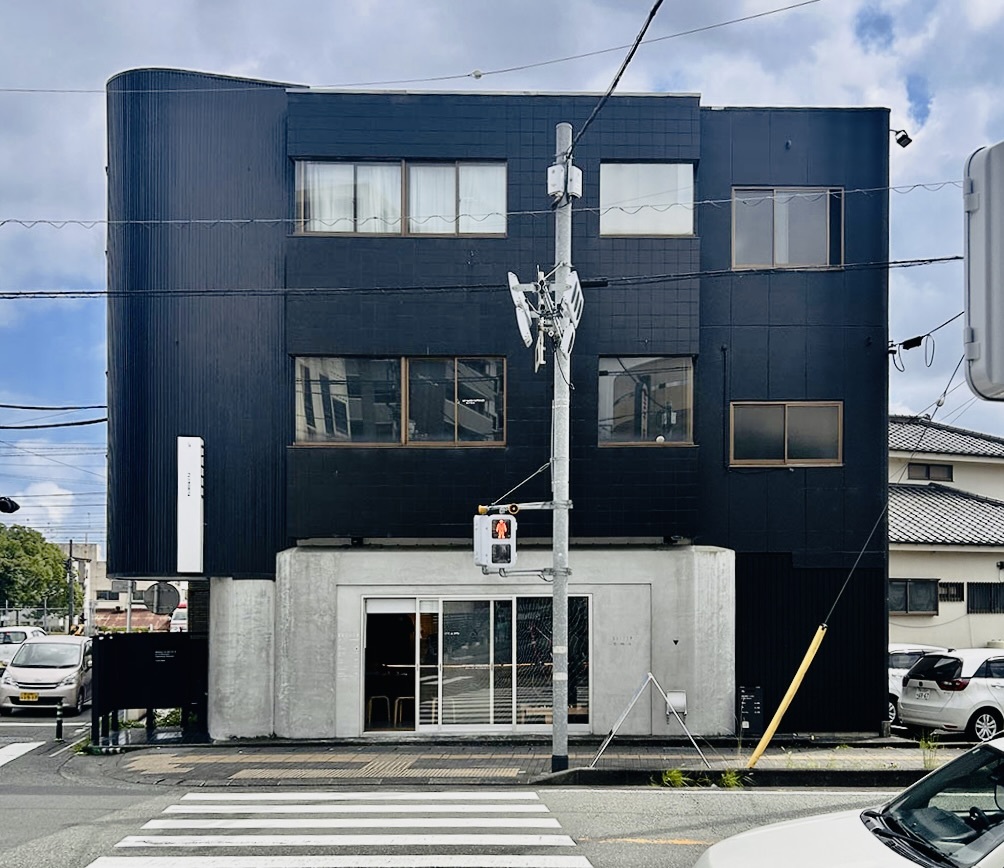
Taiki-san pointed me to the nearest konbini so I could fuel up for what was about to be a rather long day. I rode along with Taiki and Yogesh to EXP._Atelier - they were preparing for a guest to arrive that evening. The journey there was enlightening in a few ways. Taiki is EXP.’s newest XO, and his enthusiasm for the job is infectious. Formerly a law student, he would later tell me how proud he is of Fujinomiya, and how he wants to show people how great the area is. This was the first of a few encounters of earnest local pride on this trip - something I think truly makes an impact on those who come across it.
The other thing I noticed on the drive to Atelier were the various husks of hotel ventures at the roadside. Not just small projects, large developments with 30 or 40 rooms sat derelict amongst the homes and businesses of Fujinomiya’s denizens. It stirred memories of Disco Elysium’s eerie ‘Doomed Commercial Area’. Why had these businesses that investors had clearly had a huge amount of faith in, failed? What can I personally do to revitalise what was clearly once a vibrant tourism trade in the area? These were just a few questions I’d attempt to answer on this trip.
EXP._Atelier is a short drive from SLEEEP Fuji, but my God would it be hard to find if you didn’t have a rather precise map. I made a mental note to request that we install some signage. This hiddenness is, however, part of what draws people to Atelier. Though I dislike the phrase, it truly is nestled into the surrounding forest. Up a dirt track, the trees part to reveal the calligraphy-laden noren of the building, and a stone path that leads you to its door.
The noise of the world fades around you, absorbed by the dense foliage; in its place is the gentle sound of the Shiba river. I love kominka because the building’s tell you stories. They feel ‘lived in’ despite possible years of emptiness. The building spoke of years of quiet happiness. Worn floors give way to memories of tired feet, returning from hikes through the Inokashira forest. The view of the garden through the Shoji told tales of slow, romantic mornings watching the minutes go by with freshly brewed coffee.
As Yogesh and Taiki worked on the upkeep of the house, I explored further; though modest in size, Atelier hides a fair few secrets. Storage where you think there wouldn't be any, a cosy library/ home office, and its jewel, a narrow writer’s nook. As you enter and round the corner, a map of the world sits behind you. Ahead of you is a cushion resting at the base of a short-legged table. The tools of a calligrapher; ink and well, a brush, and a scroll with the practising of writers who came before you. The wall directly in front of this is a scroll with kanji neither me nor Google Translate could read. The space invites you to try your hand at the skill - the scroll half unravelled, ready for its next drink of wet ink, and the walls seemingly narrowing towards the worktop. Your focus is magnetically drawn down the corridor.
Despite the age of the home, it has been gently dragged into the comforts of the present day. The kitchen marries old and new, a modern cooktop and a spacious fridge overlook a vintage basin and a zaru (a sieve made for rinsing soba noodles), whilst its bathroom and restroom are suitably adapted to the modern Japanese high standard of TOTO excellence. This served as a primer of sorts for the next location I would travel to.
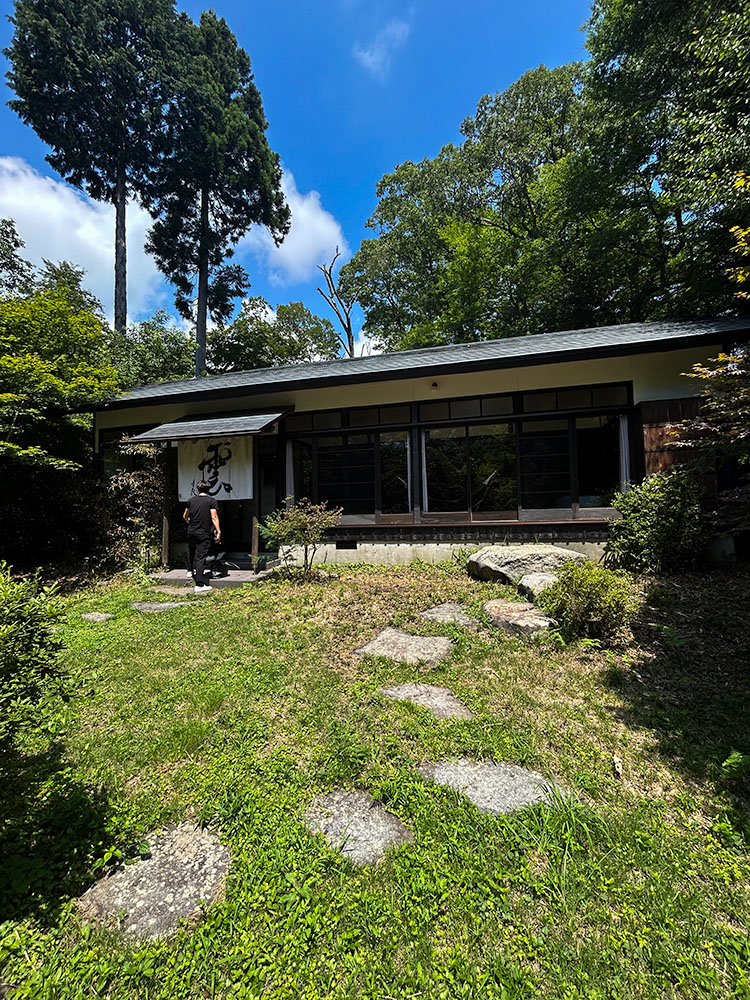
After my new friends had diligently carried out their duties, we travelled back to SLEEEP to grab a quick bite - Yakisoba, a Fujinomiya speciality. The food and drink, as I’m sure it is for many others, is probably my favourite part of Japan and I was excited to try what I’d heard was something special. Fujinomiya yakisoba is different to its other regional variants; the noodles chewier and the meat scraps within, tastier. The noodles are fried atop a teppan, somehow yielding a less greasy product than their western flat-top grill cousins. Maybe a mark of the chef’s skill, or some curious otherworldly power of the hot metal surface. Fujinomiya yakisoba (or mine at least) is laden with crispy scraps of squid and pork; these alternating with the bounce of the noodles alongside a ravenous appetite from my travel itinerary led to a clean plate in minutes. Probably should have got a large.
I rendezvoused with Jun and Azumi at SLEEEP and we headed to one of our future projects. We pulled up to a large property that looked like it had jumped out of a Hiroshi Nagai painting. It was interesting to once again see the clash of human-made structures and nature. The brutalist monolith was surrounded by a sea of green; once well-groomed, the garden had begun to revert back to a wilder state. Entering the building, you’re confronted with more juxtaposition. Instead of a futuristic interior that the facade would suggest, there is a rustic, retro-traditional carpeted vibe. Though there we didn’t have much time to spend here, it sparked excitement for what the future holds for the project. Smells of fat dripping onto flame and the sounds of excited murmuring from anticipant would-be diners filled my mind.
And with that, we were on our way to Osaka.
Osaka and The World Expo
Though we didn’t spend time in the city, transit to our dinner destination was abuzz with energy. A torrent of tourists and Nihonjin flowed alongside one another in the quest for the next train or exit. You could see and feel that Osaka is one of Japan’s international tourist hubs. After some time on the metro, we were met up with some of our partners in a suburb between Nara and Osaka. My Japanese is somewhat lacking so communication was hard, but I was made to feel welcome nonetheless. Dinner was at a local restaurant that specialises in mushrooms - this was a first for me, but I was intrigued by the idea of a mycelial omakase. Wave after wave of fungal fruiting bodies landed on the tablecloth, each one prepared slightly differently. First a mushroom consommé, then a mushroom & steak carpaccio, then a mushroom nabe and so on and so forth.
We used Google’s real-time speech-to-text translator to help me communicate with mixed success… Nevertheless, the conversations that I did comprehend were enlightening. Painting a picture of genuine concern for the preservation of Japan’s cultural artefacts. Akiya of course, included in this, but the discourse extended to local festivals with declining attendance and artisans’ difficulty in finding apprentices to carry the information to the next generation.
There’s very clearly a space outside of government initiatives and pure tourism that needs occupying.
At the dinner, our plans for the coming days changed - we discovered that one of our peers at dinner was a Nagasaki local. She shared a taste of the region’s rich history and offered to show us around. The second encounter of that local pride I spoke about earlier. Iku-e shared how Nagasaki was the site of a deep religious background, as well as the only place that traded with the outside world for hundreds of years. Nagasaki, despite its rich cultural roots, had also been a victim of the mounting exodus of people towards Japan’s larger cities. Our interest was piqued.
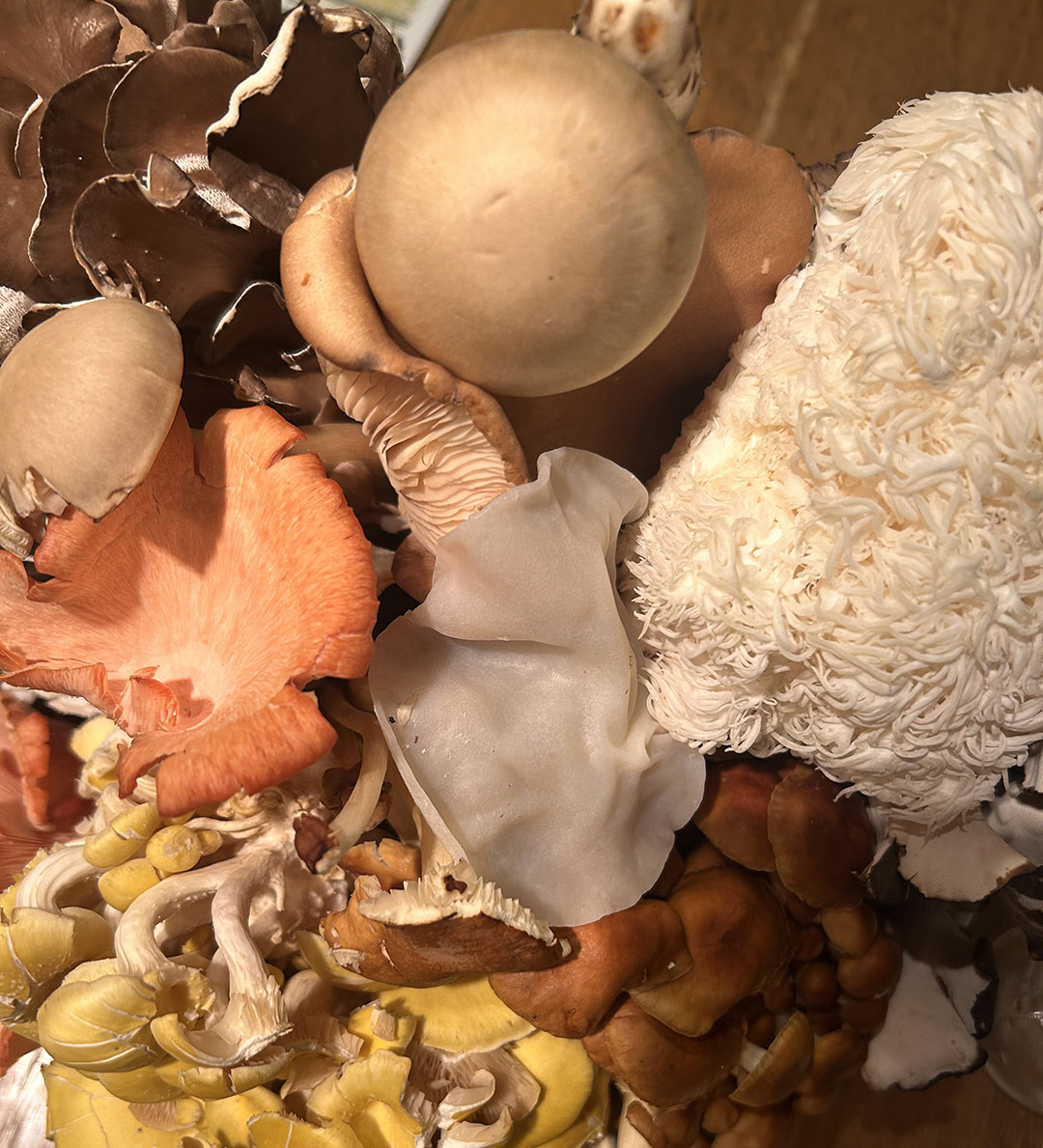
One thing I haven’t quite come to terms with in Japan is the buckwheat pillows. I woke up with a sore neck and shoulder, and decided it would probably be a good time to become an onsen initiate. I recalled reading in my colleague Yuval’s book that fewer young Japanese people are embracing public bath culture - another cultural icon up for preservation.
The breakfast buffet was extensive. I was particularly impressed by the pancake-making machine. More human engineering ingenuity at its finest. The main activity on the day’s agenda was the World Expo. I wasn’t really sure what to expect from it, having only recognised the event after being reminded that it’s the same one that the Eiffel Tower was built for. Even after that realisation, I still had no idea what it would entail.
Upon arriving at the expo, the first thing that struck me was the scale of the operation. Hundreds of thousands of square metres to accommodate all of the countries’ ‘booths’ in attendance. This year’s theme was “Designing A Future Society For Our Lives”. Something theoretically aligned with the EXP. Mission - I was excited to see how the best and brightest of the world’s many nations would bring this statement to life. Sadly, for the most part, they did not produce.
Though impressive, and great representations of their countries, the exhibitions largely lacked substance, taking on the shape of gross displays of soft power.
Few countries addressed the theme, and even fewer did so in a sustainable way.
What I did see was a meeting of cultures; stories from all corners of the Earth congregating within Osaka’s giant wooden megastructure. Somewhat inspiring, but missing the mark of an ideal future society. Portugal’s display was the outlier: a skeleton structure hung with mariners’ ropes. The interior was nautically themed, giving information on how they’re preserving marine biodiversity, marine-based renewable energy, and an immersive video that encouraged the viewers, as individuals, to take better care of the ocean. It struck a chord - they were the only nation addressing an issue that would truly be a barrier to a better tomorrow. That being said, as a spectacle, the expo was incredible, and it was great to see so many people from so many places coming together to appreciate one another, despite their nation’s differences.
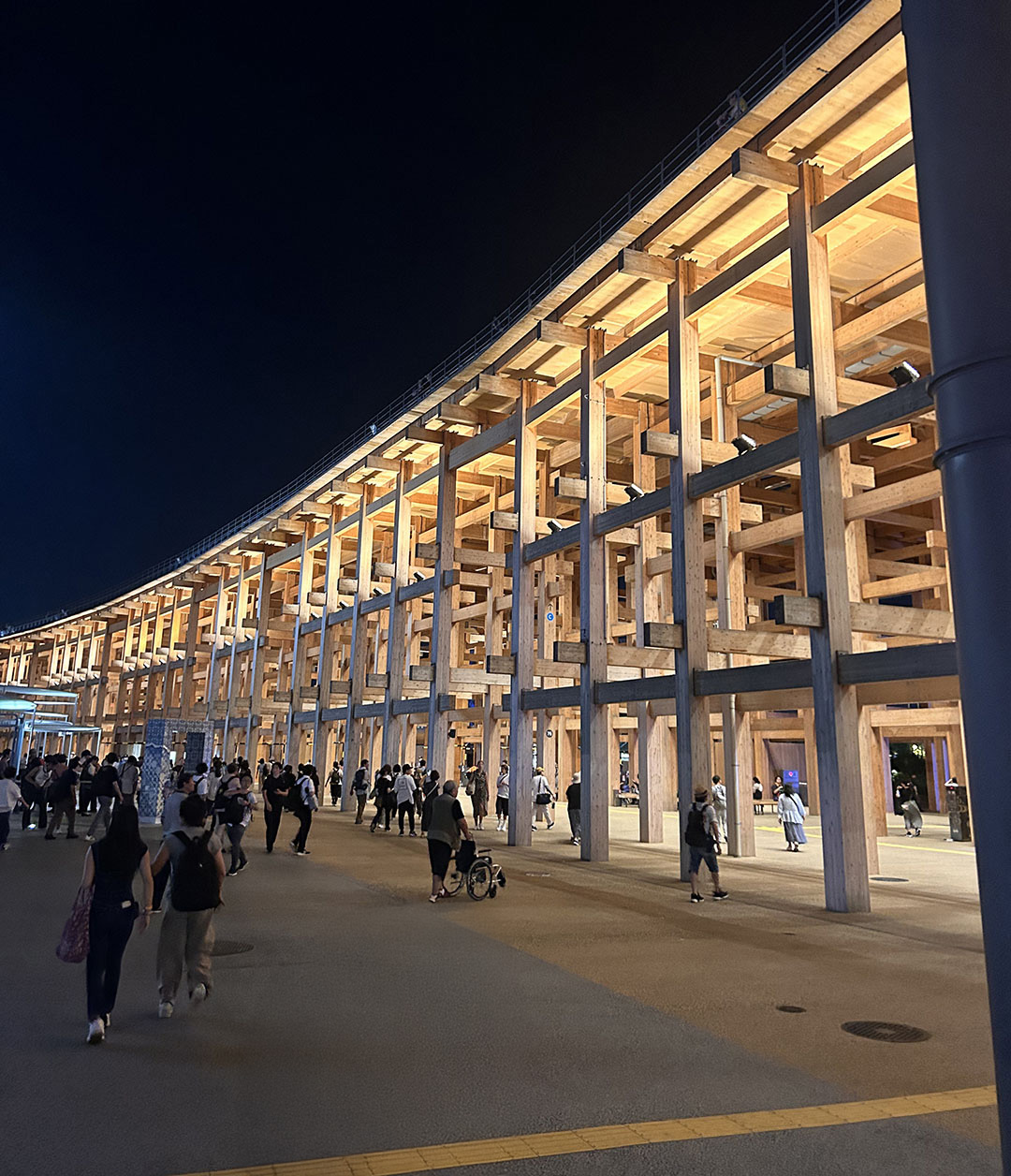
The next day took us south to meet up with Iku-e-san in Nagasaki. A destination which quickly became my favourite part of Japan that I’ve visited.
It seems a lot more relaxed than other large cities, hitting the sweet spot between a sleepy beach town and a lively metropolis. Western influences permeate the city’s architecture; a remnant of the city’s history as Japan’s only connection to the outside world. We’d spend the day taking in much of this history, starting with Oura Cathedral - the oldest Western-style building in Japan, and a monolith to the resilience that belief can instil within a population. 200 years of oppression couldn’t overcome it, and the church’s influence remains in Japan today. Next to the cathedral is Glover Garden, an estate which holds the claim as the longest standing Western-style wooden building. Its story is different: As Japan opened itself up to the world, Thomas Glover rushed there to establish himself as a trader, setting up a host of businesses once he arrived. These include Mitsubishi and Kirin. The contrast of the two buildings is almost jarring; one a testament to human resistance, and the other one to its potential for connection and collaboration. For those wondering how these were left standing after the bombing of Nagasaki, it’s because a mountain between the drop site and a significant part of the city protected it from the blast.
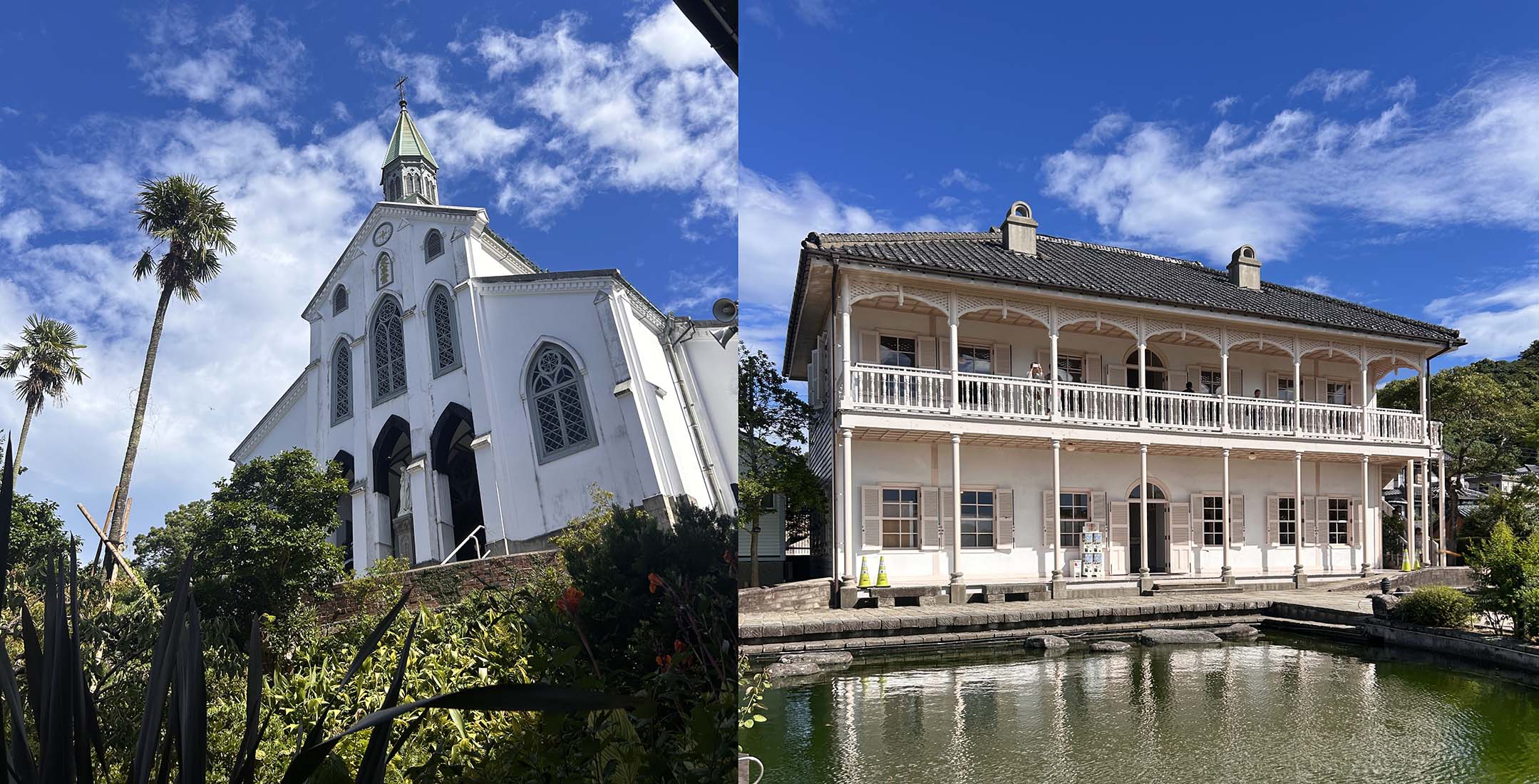
Having absorbed a fraction of the city’s history, we headed down into one of its commercial districts. The journey there was the third instance of the aforementioned local pride. A taxi driver drove us through the city streets whilst pointing out curiosities enthusiastically. Halfway there, he handed Azumi a biscuit, which I could only assume was a local speciality. Though fleeting, this interaction left a lasting impression on me. The older gentleman’s love for the city he resides in was overwhelming.
Pleasant music played over speakers dispersed along the pedestrianised streets, and shopkeepers went about their regular business. We bounced from street to street, looking at vacant lots and empty buildings, asking the question of ourselves as to how we could slot into the community built here. The offerings were a very mixed bag; a few specialty shops selling baked goods, hairdressers that doubled as bars, izakaya and more. We saw other tourists strolling through the quiet streets also equally enthralled by its charm. I noticed that the kominka were spread throughout this area irregularly. Neighboured by newer developments, they stuck out as points of resistance, just like the church on the hill. As we returned to the station to collect our luggage, the city started to wake up again. It reminded me of how Spanish towns fall silent for siesta in the afternoon and spring back to life once the heat fades away. Young people congregated around the mall, whilst those old enough to indulge in alcohol could be seen gathering in hole-in-the-wall bars and music venues. All signs of a healthy nightlife, something that often struggles in larger cities due to soaring rents. Could this be a side effect of nationwide urbanisation? And could it also be something that eventually draws people back to the city?
That marked my final day in Japan before transit back to Hong Kong. I left tired, but also with a deeper understanding of the place in which we operate. I understood more about our team, and more about the people who live alongside our Bases. I’ll stop rambling and leave a few key takeaways below:
1. How can we be as impactful as possible?
Through integration with communities within the regions we enter. Being in the travel business is not just about taking advantage of your surroundings, but instead about enhancing the community as a whole. To build human connection between travellers and those who provide a service to them, they must come to an understanding deeper than just a social transaction. It is not merely about tourists providing businesses with revenue, or business owners providing tourists with a glimpse of ‘The Other’. We have the ability to act as facilitators and connectors to cultures not only on a regional scale, but a global one.
2. How can we improve what we do?
Giving people the flexibility to choose their own journey alongside our offerings. If we are rigid, how can we promote the value of freedom? Connecting people in an organic fashion as possible must become our MO. Some may prefer a guided virtual tour in the shape of a mission, but we must also facilitate people doing this without committing to one specific route. If we can curate media that helps people to discover an area, and the people in it, then we have still done our job. This isn’t to say that we can’t also be the home of our communities, but we should help them to broaden their horizons at the same time. Not just a centre for people to gather within, but a hub that they can discover more because of.
3. What can I do to contribute to our mission?
My job is to communicate— a big upside of this trip was being able to connect with our team in Japan, and the people of Japan too. As I don’t speak Japanese (yet), developing an understanding of the market can sometimes be challenging. Narrowing this disconnect will help us to build a community on a more global scale. I spoke with Jun a lot about why we do what we do and how to make our why more prominent in our messaging. This doesn’t mean cut and pasting it onto every page of our website, but by effectively using and leveraging our touchpoint with all of our guests, partners, and users.
I also want to use my position to amplify people’s stories. I had three very memorable moments with people who are extremely proud of the places where they live. I think that these voices are some of the most powerful when it comes to making others understand why somewhere is special. They know things others don’t, they know places others don’t, and they have a contagious passion for their homes. Often these people go unconnected, those who may need it the most.
I feel like I’m just scratching the surface of my thoughts and what’s possible for the future, but I’ll leave that for another piece of writing. I hope in reading this, you feel galvanised to better connect with the people you’re alongside every day, and also to those you are yet to meet.
XO
Jordan



